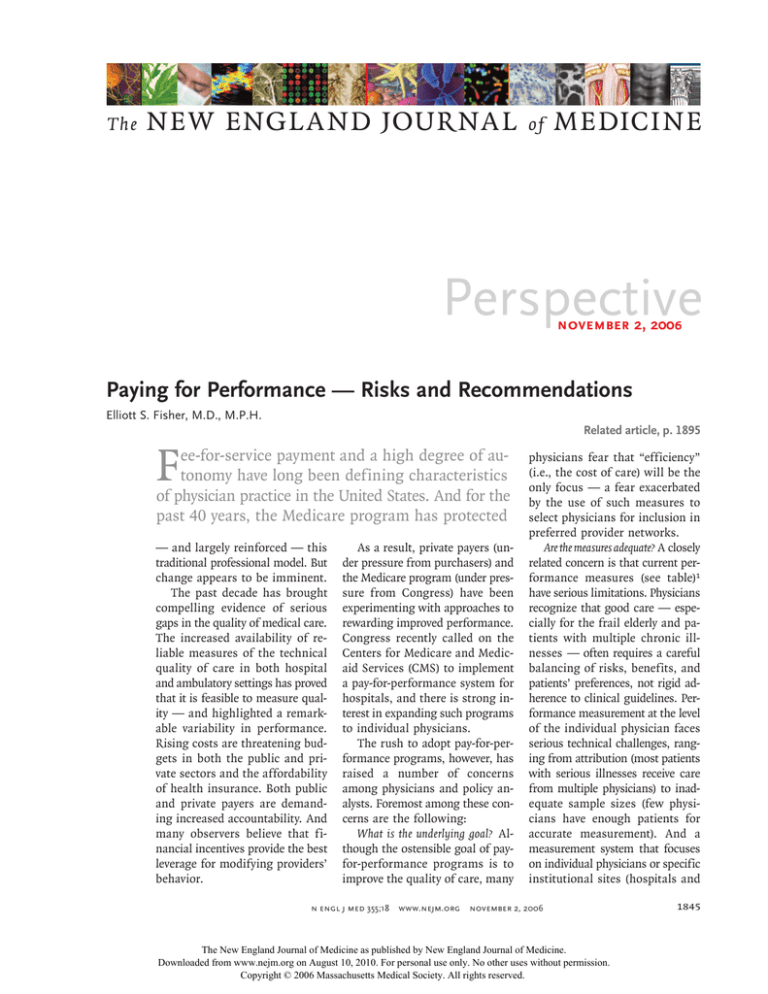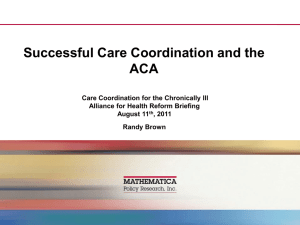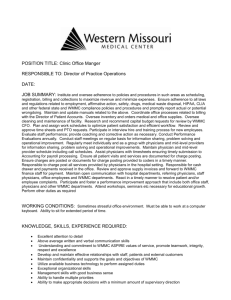
The
NEW ENGLA ND JOURNAL
of
MEDICINE
Perspective
november 2, 2006
Paying for Performance — Risks and Recommendations
Elliott S. Fisher, M.D., M.P.H.
Related article, p. 1895
F
ee-for-service payment and a high degree of autonomy have long been defining characteristics
of physician practice in the United States. And for the
past 40 years, the Medicare program has protected
— and largely reinforced — this
traditional professional model. But
change appears to be imminent.
The past decade has brought
compelling evidence of serious
gaps in the quality of medical care.
The increased availability of reliable measures of the technical
quality of care in both hospital
and ambulatory settings has proved
that it is feasible to measure quality — and highlighted a remarkable variability in performance.
Rising costs are threatening budgets in both the public and private sectors and the affordability
of health insurance. Both public
and private payers are demanding increased accountability. And
many observers believe that financial incentives provide the best
leverage for modifying providers’
behavior.
As a result, private payers (under pressure from purchasers) and
the Medicare program (under pressure from Congress) have been
experimenting with approaches to
rewarding improved performance.
Congress recently called on the
Centers for Medicare and Medicaid Services (CMS) to implement
a pay-for-performance system for
hospitals, and there is strong interest in expanding such programs
to individual physicians.
The rush to adopt pay-for-performance programs, however, has
raised a number of concerns
among physicians and policy analysts. Foremost among these concerns are the following:
What is the underlying goal? Although the ostensible goal of payfor-performance programs is to
improve the quality of care, many
n engl j med 355;18
www.nejm.org
physicians fear that “efficiency”
(i.e., the cost of care) will be the
only focus — a fear exacerbated
by the use of such measures to
select physicians for inclusion in
preferred provider networks.
Are the measures adequate? A closely
related concern is that current performance measures (see table)1
have serious limitations. Physicians
recognize that good care — especially for the frail elderly and patients with multiple chronic illnesses — often requires a careful
balancing of risks, benefits, and
patients’ preferences, not rigid adherence to clinical guidelines. Performance measurement at the level
of the individual physician faces
serious technical challenges, ranging from attribution (most patients
with serious illnesses receive care
from multiple physicians) to inadequate sample sizes (few physicians have enough patients for
accurate measurement). And a
measurement system that focuses
on individual physicians or specific
institutional sites (hospitals and
november 2, 2006
The New England Journal of Medicine as published by New England Journal of Medicine.
Downloaded from www.nejm.org on August 10, 2010. For personal use only. No other uses without permission.
Copyright © 2006 Massachusetts Medical Society. All rights reserved.
1845
PE R S PE C T IV E
Paying for Performance — Risks and Recommendations
Selected Quality Measures for Ambulatory Care.*
Measure
Definition
Preventive services
Cervical cancer screening
Tobacco use
Diabetes
Blood glucose testing
Blood glucose control
Depression
Acute-phase depression
management
Continuation-phase depression
management
Percentage of women who had one or more Pap tests during the measurement year or previous 2 years
Percentage of patients who were queried about tobacco use one or more times during the
2-year measurement period
Percentage of patients with diabetes with one or more tests of glycated hemoglobin conducted during the measurement year
Percentage of patients with diabetes whose most recent level of glycated hemoglobin was
greater than 9.0% (poor control)
Percentage of adults who were diagnosed with a new episode of major depression and were
treated with an antidepressant medication who continued to take an antidepressant during the entire 12-week acute treatment phase
Percentage of adults who were diagnosed with a new episode of major depression and treated
with an antidepressant medication who continued to take an antidepressant for at least 6
months
Measures addressing overuse
Treatment of upper respiratory
infection (URI)
Percentage of patients who were given a diagnosis of URI and were not dispensed an antibiotic
prescription on the day of the episode or within 3 days
Testing of children with
pharyngitis
Percentage of patients who were given a diagnosis of pharyngitis, were given a prescription
for an antibiotic, and underwent a group A streptococcus test
* Measures are from the 26-item starter set recommended by the Performance Measurement Workgroup of the Ambulatory
Quality Alliance.1 Pap denotes Papanicolaou.
nursing homes) risks reinforcing the fragmentation and lack
of coordination that are perhaps
the greatest failing of the current
delivery system.
Is implementation feasible? Even
for hospitals and large medical
groups, the investments required
to collect the measures for current
public-reporting initiatives are substantial. Physicians in small-office
practices — still the vast majority
— will have to collect the data by
hand through a review of medical records or make major investments in electronic health
records. Audits will be required
to ensure accuracy, and the costs
will be high.
Will rewards be sufficient? Whether the potential bonuses will be
sufficient to compensate for the
costs of data collection or to motivate change is unknown. If the
pool of funds for provider payments is fixed, then a policy that
creates large rewards for some
1846
could require substantial cuts in
payments for others. If only physicians achieving a high level of
performance receive payments,
those for whom such a level is out
of reach will not bother to try.
Could there be unintended consequences? Perhaps the greatest fear
is that implementation of pay for
performance could cause more
harm than good. For instance,
unless physicians are firmly convinced that risk adjustment is
sufficient, they could decide that
the easiest way to achieve high
scores is to avoid sick or challenging patients (those who need them
the most); systems serving the disadvantaged could see their revenues fall (undermining our tattered safety-net programs); and
the emphasis on financial incentives could further undermine
morale and the core professional
value of altruism that is already
threatened by the increasing commercialization of medicine.
n engl j med 355;18
www.nejm.org
These concerns, among others,
are discussed in a report recently
released by the Institute of Medicine (IOM) called “Rewarding
Provider Performance: Aligning
Incentives in Medicare.”2 The IOM
committee, on which I served, acknowledged these challenges but
strongly recommended moving
forward with pay for performance
as one element of a comprehensive
strategy to improve the quality of
care. Each of the aforementioned
concerns was addressed in our
recommendations.
The committee pointed to the
current payment system as an important cause of the fragmentation, complexity, unreliability, and
waste of the current delivery system. We called on the CMS and
Congress to begin implementing
pay for performance as a means to
learn how to modify the payment
system to foster higher performance and encourage systemwide
and comprehensive improvement.
november 2, 2006
The New England Journal of Medicine as published by New England Journal of Medicine.
Downloaded from www.nejm.org on August 10, 2010. For personal use only. No other uses without permission.
Copyright © 2006 Massachusetts Medical Society. All rights reserved.
PE R S PE C TI V E
Paying for Performance — Risks and Recommendations
We emphasized that measures
and rewards of performance
should target multiple dimensions
of care, initially including measures of technical quality, patientcentered care, and efficiency but
moving toward longitudinal and
health-outcome measures as soon
as it is feasible. Because most
Medicare beneficiaries receive care
from multiple physicians in diverse
institutional settings, the committee highlighted the need for
measures and rewards that foster
shared accountability and coordination of care. Given the current
threats to primary care, we recommended allowing Medicare
beneficiaries to identify their regular care providers, and then rewarding such providers.
Although we called on the CMS
to mandate that all Medicare institutional providers participate in
pay-for-performance programs as
soon as possible, we recognized
the serious challenges faced by
physicians in small-office practices
and recommended that participation by physicians be voluntary at
first. Special efforts will be required to assist providers in developing data-collection systems
and adopting the electronic health
records required to support quality
improvement, performance measurement, and payment reform.
We recognized that substantial
additional funding will not be
forthcoming in the current fiscal
environment and called for the
creation of modest funding pools
derived from current payments.
Annual changes in payment rates
would be a likely source, so that
some providers could see little or
no increase in fees. All providers,
however, should be able to receive
performance rewards if payments
are targeted to multiple dimensions of care and both improvement and achievement are rewarded.
Finally — and perhaps most
important — the committee (recognizing that the evidence underlying pay for performance is weak
and that unintended effects are
possible) called on the federal government to implement pay for performance in the context of an effective monitoring and evaluation
system that assesses early experiences (in order to identify potential harms and take corrective
action), evaluates the approach’s
impact broadly (on all aspects of
care), and identifies and disseminates information on how best to
improve performance.
Unfortunately, much of the current work in performance measurement and pay for performance
seems to ignore one or more of
the commonsense principles outlined by the IOM committee. The
technical quality measures still
reflect a tiny segment of clinical
practice. The efficiency measures
used or under discussion target
discrete diagnoses and episodes
(which can make fragmented care
by multiple providers appear “efficient”), rather than the longitudinal costs and outcomes of care
(which would reward comprehensive, coordinated care by single
providers). Much of the focus appears to remain on the measurement of individual performance of
physicians — a daunting technical and administrative challenge
if implemented nationally. And
little attention is being devoted
to designing or building a comprehensive evaluation framework
that would allow us to learn from
our inevitable mistakes.
The shift from autonomy to accountability and from fee-for-service practice to new methods of
payment appears inevitable. Accountability for performance on
the basis of evidence is now the
watchword for clinical services. We
would be wise to apply a similar
standard to the implementation
of our health policy reforms.
An interview with Dr. Fisher and Dr. Karen Davis on pay for performance, Medicare, and the
IOM report can be heard at www.nejm.org.
Dr. Fisher is a professor of medicine at
Dartmouth Medical School, Hanover, NH,
and the VA Outcomes Group, White River
Junction, VT.
1. The Ambulatory Care Quality Alliance recommended starter set: clinical performance
measures for ambulatory care. Rockville,
MD: Agency for Healthcare Research and
Quality, 2004. (Accessed October 12, 2006,
at http://www.ahrq.gov/qual/aqastart.htm.)
2. Institute of Medicine. Rewarding provider
performance: aligning incentives in Medicare. September 2006. (Accessed October
12, 2006, at http://www.iom.edu/CMS/3809/
19805/37232.aspx.)
Public Report Cards — Cardiac Surgery and Beyond
Robert Steinbrook, M.D.
T
he debate about public report
cards for physicians and hospitals never seems to end.1 Some
praise report cards for their role
in improving the quality of care,
patient safety, and the choices
of patients, referring physicians,
and organizations that purchase
health care. Others argue that
such reports can have negative
consequences — for example, if
physicians or hospitals, in order
n engl j med 355;18
www.nejm.org
to protect their rankings, avoid
performing surgery on severely ill
patients for whom surgical treatment might otherwise be recommended. Nonetheless, more and
more data are being collected and
november 2, 2006
The New England Journal of Medicine as published by New England Journal of Medicine.
Downloaded from www.nejm.org on August 10, 2010. For personal use only. No other uses without permission.
Copyright © 2006 Massachusetts Medical Society. All rights reserved.
1847







